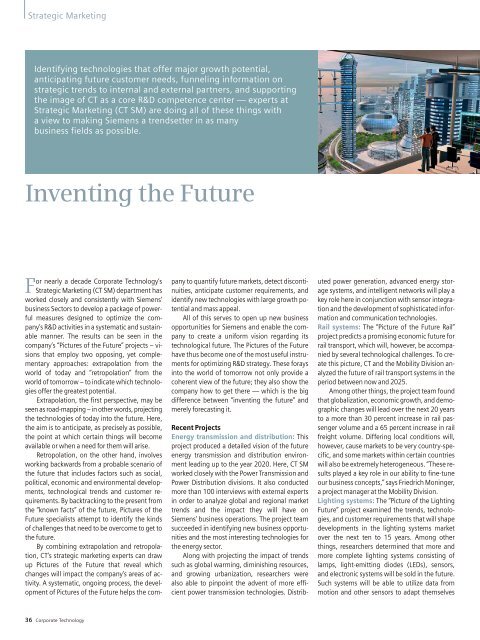Corporate Technology - Rolf Hellinger
Corporate Technology - Rolf Hellinger
Corporate Technology - Rolf Hellinger
You also want an ePaper? Increase the reach of your titles
YUMPU automatically turns print PDFs into web optimized ePapers that Google loves.
Strategic Marketing<br />
Identifying technologies that offer major growth potential,<br />
anticipating future customer needs, funneling information on<br />
strategic trends to internal and external partners, and supporting<br />
the image of CT as a core R&D competence center — experts at<br />
Strategic Marketing (CT SM) are doing all of these things with<br />
a view to making Siemens a trendsetter in as many<br />
business fields as possible.<br />
Inventing the Future<br />
For nearly a decade <strong>Corporate</strong> <strong>Technology</strong>’s<br />
Strategic Marketing (CT SM) department has<br />
worked closely and consistently with Siemens’<br />
business Sectors to develop a package of powerful<br />
measures designed to optimize the company’s<br />
R&D activities in a systematic and sustainable<br />
manner. The results can be seen in the<br />
company’s “Pictures of the Future” projects – visions<br />
that employ two opposing, yet complementary<br />
approaches: extrapolation from the<br />
world of today and “retropolation” from the<br />
world of tomorrow – to indicate which technologies<br />
offer the greatest potential.<br />
Extrapolation, the first perspective, may be<br />
seen as road-mapping – in other words, projecting<br />
the technologies of today into the future. Here,<br />
the aim is to anticipate, as precisely as possible,<br />
the point at which certain things will become<br />
available or when a need for them will arise.<br />
Retropolation, on the other hand, involves<br />
working backwards from a probable scenario of<br />
the future that includes factors such as social,<br />
political, economic and environmental developments,<br />
technological trends and customer requirements.<br />
By backtracking to the present from<br />
the “known facts” of the future, Pictures of the<br />
Future specialists attempt to identify the kinds<br />
of challenges that need to be overcome to get to<br />
the future.<br />
By combining extrapolation and retropolation,<br />
CT’s strategic marketing experts can draw<br />
up Pictures of the Future that reveal which<br />
changes will impact the company’s areas of activity.<br />
A systematic, ongoing process, the development<br />
of Pictures of the Future helps the com-<br />
36 <strong>Corporate</strong> <strong>Technology</strong><br />
pany to quantify future markets, detect discontinuities,<br />
anticipate customer requirements, and<br />
identify new technologies with large growth potential<br />
and mass appeal.<br />
All of this serves to open up new business<br />
opportunities for Siemens and enable the company<br />
to create a uniform vision regarding its<br />
technological future. The Pictures of the Future<br />
have thus become one of the most useful instruments<br />
for optimizing R&D strategy. These forays<br />
into the world of tomorrow not only provide a<br />
coherent view of the future; they also show the<br />
company how to get there — which is the big<br />
difference between “inventing the future” and<br />
merely forecasting it.<br />
Recent Projects<br />
Energy transmission and distribution: This<br />
project produced a detailed vision of the future<br />
energy transmission and distribution environment<br />
leading up to the year 2020. Here, CT SM<br />
worked closely with the Power Transmission and<br />
Power Distribution divisions. It also conducted<br />
more than 100 interviews with external experts<br />
in order to analyze global and regional market<br />
trends and the impact they will have on<br />
Siemens’ business operations. The project team<br />
succeeded in identifying new business opportunities<br />
and the most interesting technologies for<br />
the energy sector.<br />
Along with projecting the impact of trends<br />
such as global warming, diminishing resources,<br />
and growing urbanization, researchers were<br />
also able to pinpoint the advent of more efficient<br />
power transmission technologies. Distrib-<br />
uted power generation, advanced energy storage<br />
systems, and intelligent networks will play a<br />
key role here in conjunction with sensor integration<br />
and the development of sophisticated information<br />
and communication technologies.<br />
Rail systems: The “Picture of the Future Rail”<br />
project predicts a promising economic future for<br />
rail transport, which will, however, be accompanied<br />
by several technological challenges. To create<br />
this picture, CT and the Mobility Division analyzed<br />
the future of rail transport systems in the<br />
period between now and 2025.<br />
Among other things, the project team found<br />
that globalization, economic growth, and demographic<br />
changes will lead over the next 20 years<br />
to a more than 30 percent increase in rail passenger<br />
volume and a 65 percent increase in rail<br />
freight volume. Differing local conditions will,<br />
however, cause markets to be very country-specific,<br />
and some markets within certain countries<br />
will also be extremely heterogeneous. “These results<br />
played a key role in our ability to fine-tune<br />
our business concepts,” says Friedrich Moninger,<br />
a project manager at the Mobility Division.<br />
Lighting systems: The “Picture of the Lighting<br />
Future” project examined the trends, technologies,<br />
and customer requirements that will shape<br />
developments in the lighting systems market<br />
over the next ten to 15 years. Among other<br />
things, researchers determined that more and<br />
more complete lighting systems consisting of<br />
lamps, light-emitting diodes (LEDs), sensors,<br />
and electronic systems will be sold in the future.<br />
Such systems will be able to utilize data from<br />
motion and other sensors to adapt themselves


